Table of Contents
Ever stared at your analytics and wondered why your beautifully optimized product pages aren’t converting? You’re not alone. Most ecommerce managers are trapped in an eternal tug-of-war between pleasing Google and persuading actual humans to click “Add to Cart.”
Let’s cut through the noise. By the end of this guide, you’ll have a proven framework for product page SEO that actually boosts your conversion rate instead of killing it.
The secret isn’t stuffing product descriptions with keywords or adding technical elements that slow down your site. Effective product page optimization happens when you understand how search intent and buying psychology work together.
But here’s what most SEO guides won’t tell you about optimizing product pages: the same elements that make Google happy can actually make your customers happier too—if you know how to implement them correctly.
Understanding the Balance Between SEO and Conversion

Why Product Pages Need Both SEO and Conversion Optimization
Product pages have a tough job. They need to rank well in search results while simultaneously convincing visitors to hit that “Add to Cart” button. It’s like trying to please two different bosses at once.
Here’s the reality: Without SEO, nobody finds your products. Without conversion optimization, nobody buys them.
The best product pages don’t choose between these approaches—they blend them. Think about it: What good is ranking #1 for “blue running shoes” if your page scares away potential customers with technical jargon and poor layout?
Similarly, having a gorgeous, conversion-focused page is pointless if it’s buried on page 8 of Google where nobody will ever see it.
Successful product pages create a seamless customer journey from search engine to checkout.
Common Conflicts Between SEO and Conversion Tactics
I’ve seen this battle play out countless times:
SEO Wants | Conversion Wants |
Lots of detailed content | Clean, minimal design |
Keyword-rich headers | Benefit-focused headers |
Technical specifications | Emotional triggers |
Internal linking | Focused path to purchase |
Take product descriptions. SEO demands comprehensive, keyword-rich text. But conversion experts argue that most people don’t read long descriptions and prefer bullet points, images, and videos.
Another clash happens with calls-to-action. SEO might want multiple internal links, while conversion optimization pushes for a single, clear purchase path.
Metrics That Matter: Tracking SEO and Conversion Success
Stop measuring these aspects separately! The most valuable metrics bridge both worlds:
- Organic landing page conversion rate
- Bounce rate from organic traffic
- Average order value from organic visitors
- Keyword rankings for high-intent terms
- Page depth for organic visitors
The secret is tracking how SEO efforts directly impact your bottom line. Instead of celebrating keyword rankings alone, focus on which rankings actually bring purchasing customers.
Smart ecommerce teams now look at organic revenue per landing page rather than traffic alone. This shift reveals that sometimes a page ranking #5 for a high-intent keyword outperforms one ranking #1 for a general term.
Keyword Strategy for Product Pages That Converts.

A. Finding High-Intent Keywords That Drive Sales
Want to know the secret behind product pages that actually convert? It’s all about catching buyers when they’re ready to pull out their credit cards.
High-intent keywords are the gold you’re looking for. These are search terms people use when they’re not just browsing – they’re shopping with purpose.
Look for keywords with these buying signals:
- “Buy” or “purchase” modifiers
- Specific product names and model numbers
- Words like “best,” “top,” or “review”
- Price-related terms (“affordable,” “discount,” “premium”)
Google’s Keyword Planner isn’t enough here. Dig into your actual sales data to see which search terms led to purchases, not just clicks. Your analytics will reveal patterns that generic tools miss.
B. Natural Keyword Placement That Doesn’t Disrupt User Experience
Nobody likes keyword stuffing. It’s awkward, annoying, and screams “I care more about robots than humans.”
Your keywords should feel like they belong. Place them where they make sense:
- Product titles (naturally!)
- First paragraph of description
- Feature highlights
- Image alt text (describe what the customer sees)
- Meta descriptions that actually entice clicks
The acid test? Read it out loud. If you stumble or cringe, your customers will too.
C. Long-Tail Keywords for Specific Product Features
The magic of long-tail keywords is they catch customers who know exactly what they want.
Think about it – someone searching “waterproof bluetooth speaker with 20-hour battery” is probably much closer to buying than someone searching just “speaker.”
Build feature-specific content around:
- Technical specifications
- Unique selling points
- Problem-solving capabilities
- Usage scenarios (“perfect for camping”)
Each specific feature is an opportunity to match a customer’s exact need.
D. Competitor Keyword Analysis for Market Gaps
Your competitors are leaving money on the table. Your job is to find where.
Start by analyzing their product pages:
- Which features do they emphasize?
- What benefits do they miss completely?
- Where are their content gaps?
Tools like SEMrush or Ahrefs show you which keywords drive traffic to competitors but not to you. Those gaps are your opportunities.
Remember: the goal isn’t just to match what competitors do – it’s to catch what they’re missing.
Optimizing Product Page Structure
User-Friendly URL Structures That Search Engines Love
Want to know a secret about product page URLs? The simpler, the better.
A clean URL structure isn’t just pretty—it’s powerful. Instead of this mess:
example.com/shop/category/subcategory/p=1234?color=blue&size=medium
Go with something straightforward:
example.com/shop/blue-cotton-t-shirt
Why does this matter? Search engines can easily understand what the page is about, and so can your customers. Remember, if a human can read and understand your URL at a glance, Google probably can too.
Quick tips for URL perfection:
- Use hyphens to separate words (not underscores)
- Include your primary product keyword
- Keep it short and descriptive
- Avoid parameters when possible
- Remove unnecessary numbers and codes
Creating Compelling Meta Titles and Descriptions That Increase CTR
Your meta title and description are like your product’s billboard on search results. They need to grab attention AND deliver value.
For titles, you’ve got roughly 60 characters to work magic. Try this formula:
Primary Keyword | Key Benefit | Brand Name
For descriptions (about 155 characters), include:
- Your main selling point
- A specific benefit
- A clear call-to-action
Here’s the thing about meta descriptions—they don’t directly impact rankings, but they absolutely impact click-through rates. And guess what? Higher CTR signals to Google that your page is valuable.
The trick is writing something that makes people think, “That’s exactly what I’m looking for!” without resorting to clickbait. Promise what you can deliver, then deliver even more.
Strategic Header Tag Usage for Both SEO and Readability
Headers aren’t just for organizing content—they’re SEO goldmines.
Your product page should use headers like this:
- H1: Product name (use only once!)
- H2: Major sections (Features, Specifications, Reviews)
- H3: Subsections within those categories
But don’t just stuff keywords in there and call it a day. Your headers need to guide customers through your product story while helping search engines understand your page structure.
Think of headers as chapter titles in your product’s story. They should make sense when read alone, but even more sense when read together.
The best headers pull double duty: they contain relevant keywords AND help shoppers scan your page to find exactly what they’re looking for. When you nail this balance, both conversion rates and rankings benefit.
Schema Markup Implementation for Enhanced SERP Visibility
Schema markup is basically speaking Google’s language. It’s code that tells search engines exactly what your content means, not just what it says.
For product pages, you absolutely need Product Schema. This special markup helps Google display rich snippets with:
- Price
- Availability
- Ratings
- Reviews
The payoff? Your listings stand out in search results with those eye-catching stars and extra info. That means more clicks, more traffic, and yes—more sales.
Here’s what most store owners miss: you can combine different schema types. A product can also use BreadcrumbList schema to show its category path, and Organization schema to boost brand visibility.
Don’t worry—you don’t need to code this from scratch. Most modern e-commerce platforms have schema implementation built in or available via plugins.
Mobile Optimization Techniques That Preserve the Buying Experience
Mobile shopping isn’t the future—it’s right now. But optimizing for mobile goes beyond just making your site “responsive.”
The hard truth is that many mobile-optimized product pages lose conversions because they sacrifice functionality for speed. You need both.
Critical mobile optimization techniques include:
- Thumb-friendly tap targets (buttons at least 44×44 pixels)
- Visible product images with easy zoom capability
- Simplified navigation with sticky “Add to Cart” buttons
- Form fields that don’t trigger tiny keyboards
- Product videos that don’t autoplay on mobile data
The key is testing your mobile experience with actual shoppers. Heat mapping tools can reveal where mobile users get stuck in your buying process.
Remember, Google’s mobile-first indexing means your mobile version is what gets crawled first. So mobile optimization isn’t just about conversions—it directly impacts your SEO performance too.
Content Strategies That Rank and Sell
Crafting Product Descriptions That Satisfy Both Algorithms and Customers
Ever noticed how some product descriptions make you want to buy immediately, while others sound like they were written by robots? The sweet spot lies right in the middle.
Good product descriptions do double duty – they charm search engines and convince real humans to pull out their credit cards. Start with customer research to identify the exact words your buyers use when talking about your products. These natural phrases often make the best keywords.
Structure matters too. Front-load descriptions with important keywords, but weave them naturally into compelling narratives about benefits, not just features. Remember: Google can read keywords, but only humans can feel FOMO.
Using Bullet Points to Highlight Benefits While Including Keywords
Bullet points aren’t just easy on the eyes – they’re SEO goldmines. Break up text walls with scannable points that:
- Include primary and secondary keywords naturally
• Highlight specific product benefits (not just features)
• Use action words that trigger buying behavior
• Answer common objections before they arise
The trick? Don’t stuff keywords. Instead, craft each bullet to solve a specific customer problem while naturally incorporating relevant terms.
Incorporating SEO-Friendly FAQs That Address Buyer Concerns
FAQs aren’t just customer service tools – they’re SEO powerhouses. Create a dedicated FAQ section using question-based keywords that real shoppers are searching for.
Each question creates a perfect opportunity for featured snippets. Structure answers in 40-50 words to maximize your chances of getting that coveted position zero in search results.
Bonus tip: Update your FAQs quarterly based on actual customer service inquiries. Real questions make the best keyword opportunities.
User-Generated Content as an SEO and Social Proof Tool
Reviews and customer Q&As create fresh, keyword-rich content without you lifting a finger. They’re basically SEO on autopilot.
But the magic doesn’t stop there. User content builds trust in ways your marketing copy never could. When shoppers see real people describing your product in their own words (and often using the exact search terms they used to find you), conversion rates typically jump 15-25%.
Encourage customers to be specific in reviews. A detailed review mentioning specific product attributes and use cases does more for both SEO and conversions than generic “great product” comments.
Technical SEO Elements for Product Pages

Page Speed Optimization Without Sacrificing Visual Appeal
You know what kills conversion rates faster than anything? A slow-loading product page.
Google loves speed, and so do your customers. But here’s the tricky part – those gorgeous high-res product images that make shoppers click “Buy Now” are often the biggest culprits slowing down your pages.
Try these practical fixes:
- Implement lazy loading so images load only when scrolled into view
- Use next-gen formats like WebP (while keeping JPG fallbacks)
- Set up a Content Delivery Network (CDN) to serve assets from servers closer to your users
- Minimize render-blocking JavaScript, especially third-party scripts
One of my clients cut load time from 5.2 to 1.8 seconds while keeping their beautiful product galleries intact. Their conversion rate jumped 23% the following month.
Implementing Proper Internal Linking Without Distracting Shoppers
Internal links are SEO gold, but nobody wants to see a product page cluttered with irrelevant links that pull attention away from the “Add to Cart” button.
Smart internal linking means:
- Using breadcrumbs that show the product’s category hierarchy
- Adding “related products” sections at the bottom of the page
- Including natural links within product descriptions that don’t feel forced
- Ensuring complementary product links add value to the shopping experience
Image Optimization That Maintains Quality
Product images need to look crisp while loading quickly. It’s not an either/or situation.
Try this balanced approach:
- Compress images to 70-80% quality (the sweet spot where most people can’t tell the difference)
- Include descriptive alt text that helps both SEO and accessibility
- Use responsive images with the srcset attribute to serve different sizes based on device
- Name your image files with descriptive, keyword-rich names before uploading
Structured Data for Enhanced Product Visibility
When Google understands exactly what you’re selling, your products stand out in search results with rich snippets showing price, availability, and reviews.
Implement these structured data types:
- Product schema with price, availability, and SKU
- AggregateRating schema for customer reviews
- Offer schema for current pricing and promotions
- Brand schema to establish manufacturer information
Tests show that rich snippets can increase CTR by up to 30% – that’s huge for both SEO and conversions.
Conversion-Focused Elements That Boost SEO
A. Customer Reviews as Both Social Proof and Keyword Opportunities
Customer reviews are SEO goldmines hiding in plain sight. When shoppers leave detailed feedback, they’re essentially gifting you with natural language that other potential customers are using to search.
Think about it – a customer writing “these running shoes are perfect for marathon training” just handed you a long-tail keyword on a silver platter.
Smart ecommerce brands are:
- Encouraging specific, detailed reviews (not just “great product!”)
- Mining reviews for recurring phrases to include in product
Conclusion
Striking the perfect balance between SEO and conversion on your product pages doesn’t have to be a compromise. By implementing a strategic keyword approach, optimizing your page structure, and creating content that both ranks and sells, you can achieve the best of both worlds. Technical SEO elements like fast loading times and mobile optimization work alongside conversion-focused elements such as compelling CTAs and trust signals to create pages that satisfy both search engines and customers.
Remember that successful product pages treat SEO and conversion as complementary forces rather than competing priorities. Start by implementing these optimization strategies incrementally, testing their impact on both search visibility and conversion rates. The most effective product pages don’t sacrifice one for the other but instead create a seamless experience that guides users naturally from search results to purchase completion.
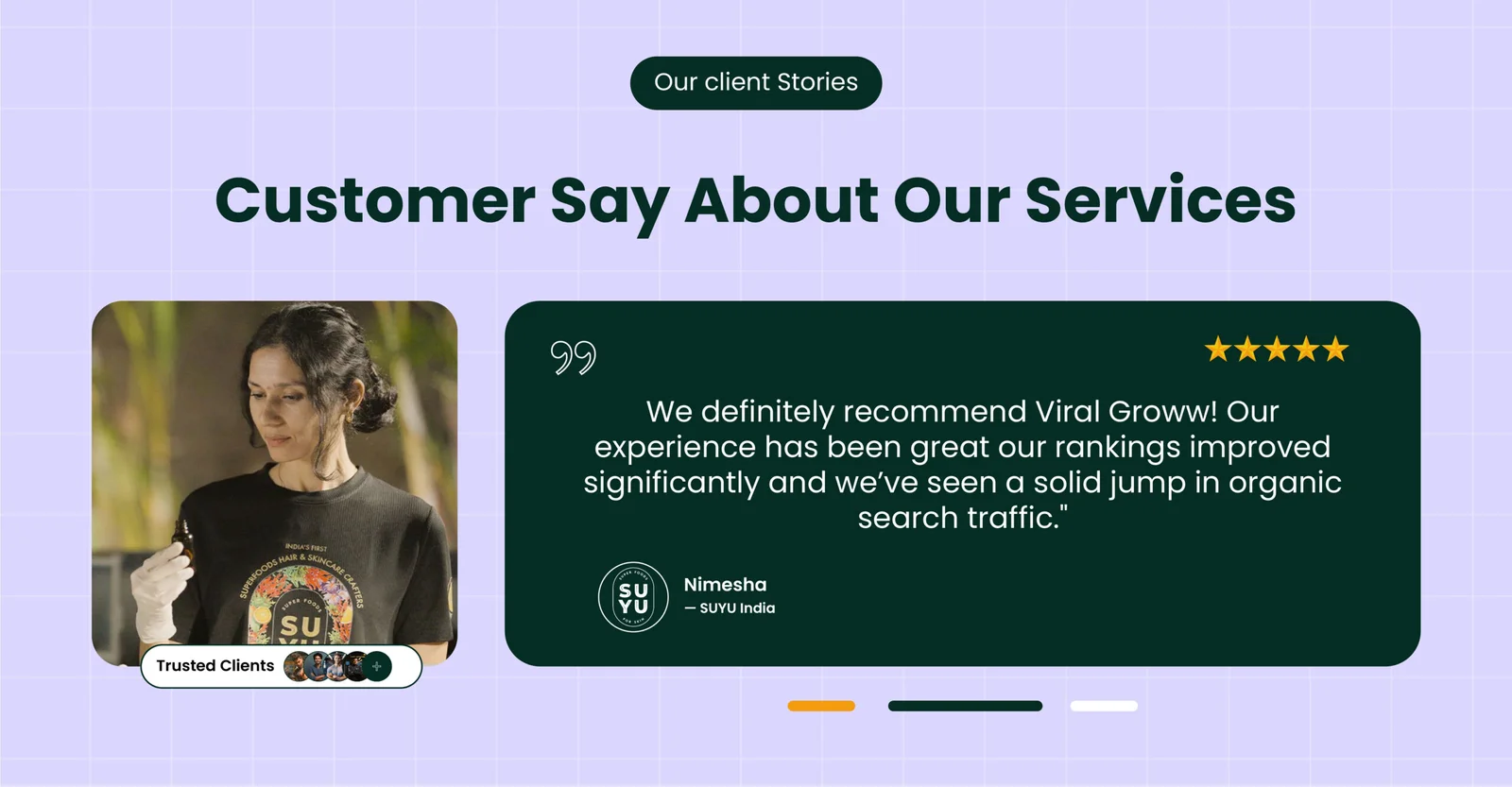
How We 2.5X’d Organic Traffic for SUYU India in Just 5 Months by Following Our White Hat SEO Framework
SUYU India was born with a clear vision—to bring superfood-powered skincare into the Indian market. Co-founded with a deep belief in sustainability.

Scaling a Sexual Wellness Brand with SEO – How We Did It for Ecstasia
Ecstasia is a sexual wellness D2C brand started by Prakhar Raj and Hamid Iqbal in December 2024. Prakhar, a school friend of mine, works in a corporate job but has always wanted to start his own business.
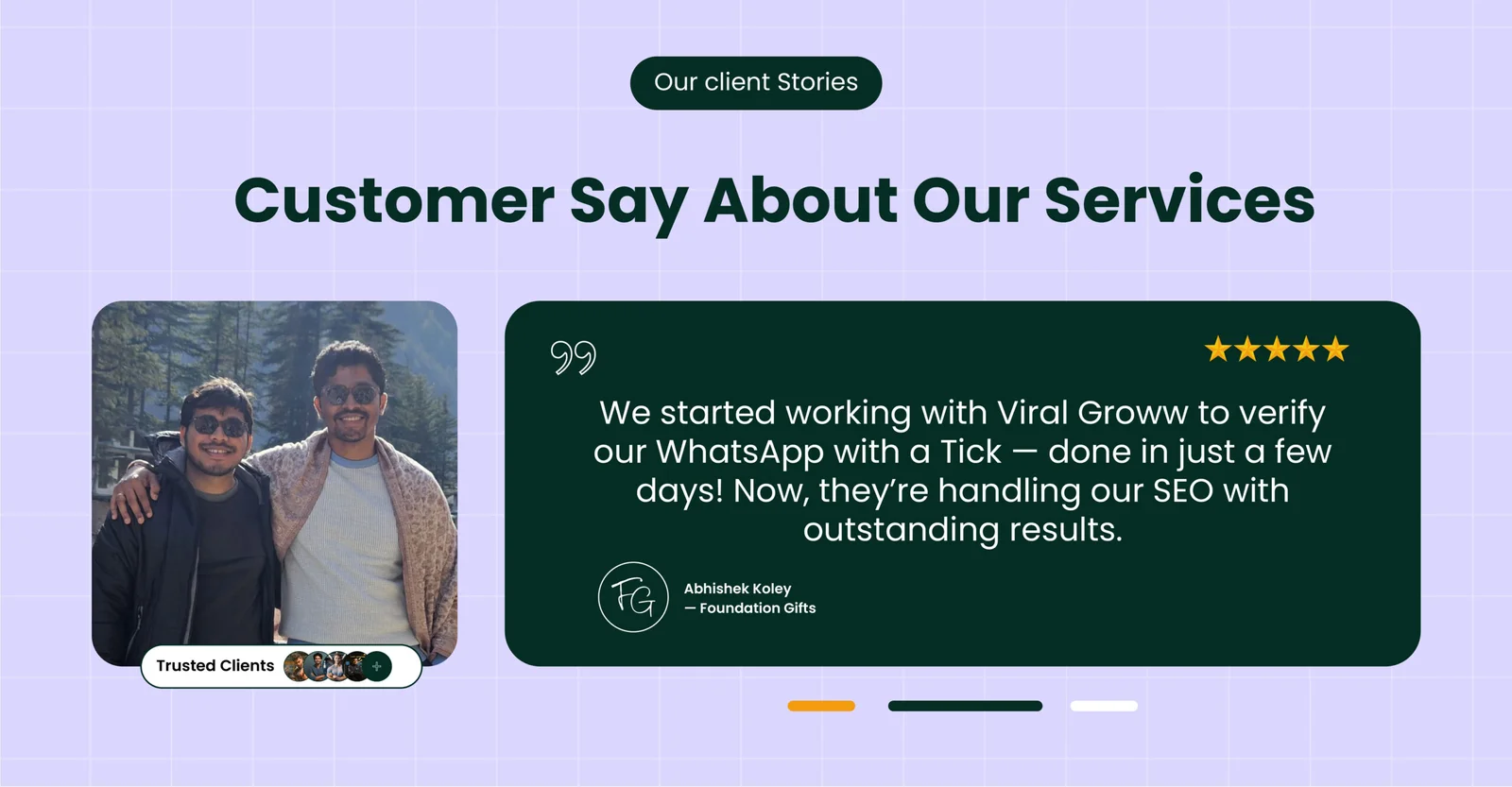
How we got 8.7X Impressions for a gifting D2C brand within 3 Months by doing White Hat SEO
Foundation Gift was started by Rakesh Adak and Abhishek Koley with a simple idea — gifts should feel just as special as the moments they celebrate.
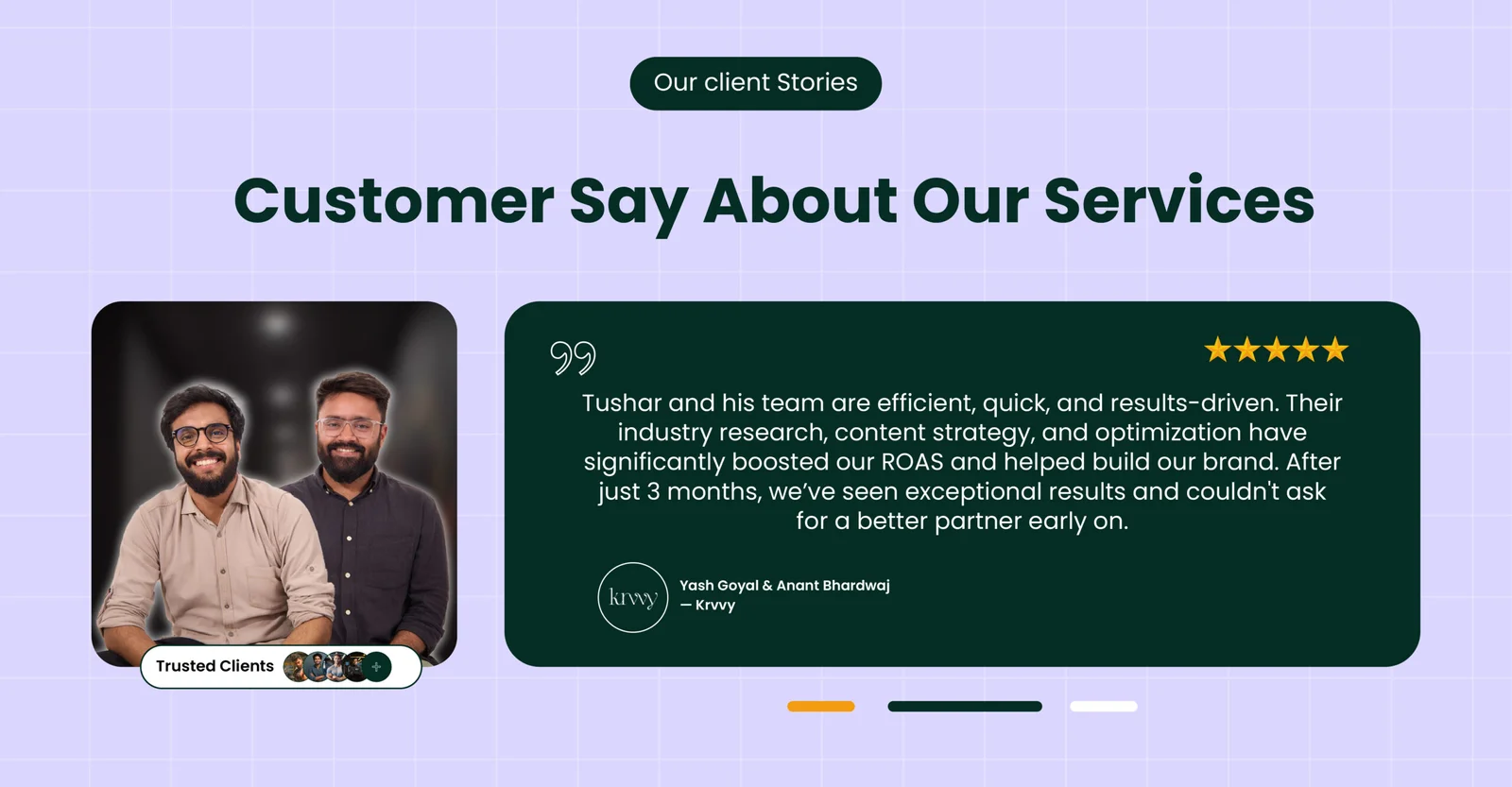
Scaling a Lingerie Brand to 7-Figure Sales in Just 75 Days—Proof Inside!
Krvvy is a modern, forward-thinking lingerie brand committed to redefining comfort and functionality. Designed to elevate the lingerie experience, Krvvy celebrates the beauty of all women, embracing and admiring every curve.
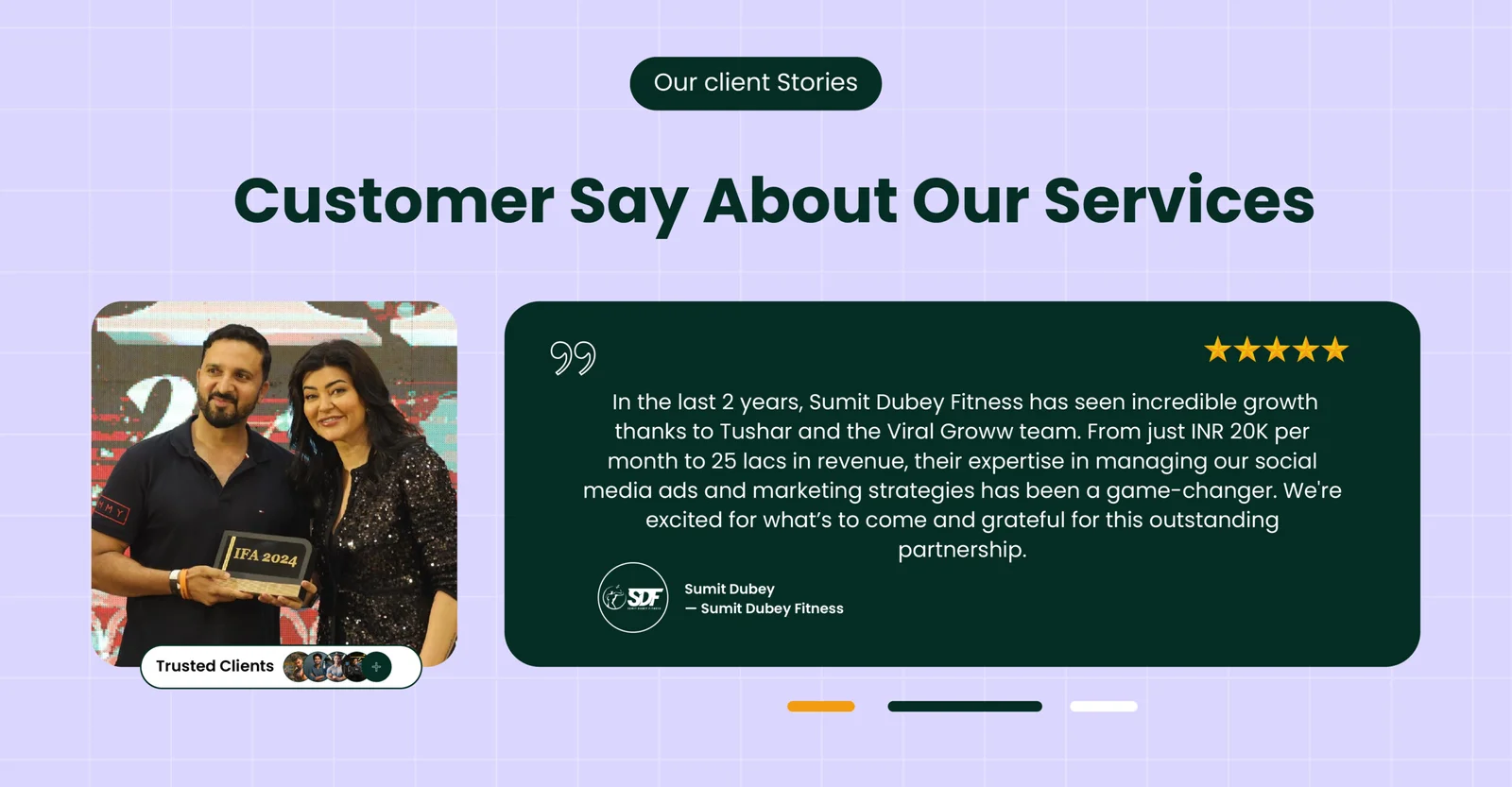
How Sumit Dubey Fitness Classes Transformed into a Fitness Empire with Strategic Digital Marketing
Sumit Dubey Fitness Classes, founded by Sumit Dubey, provides online fitness training with a personalized touch.
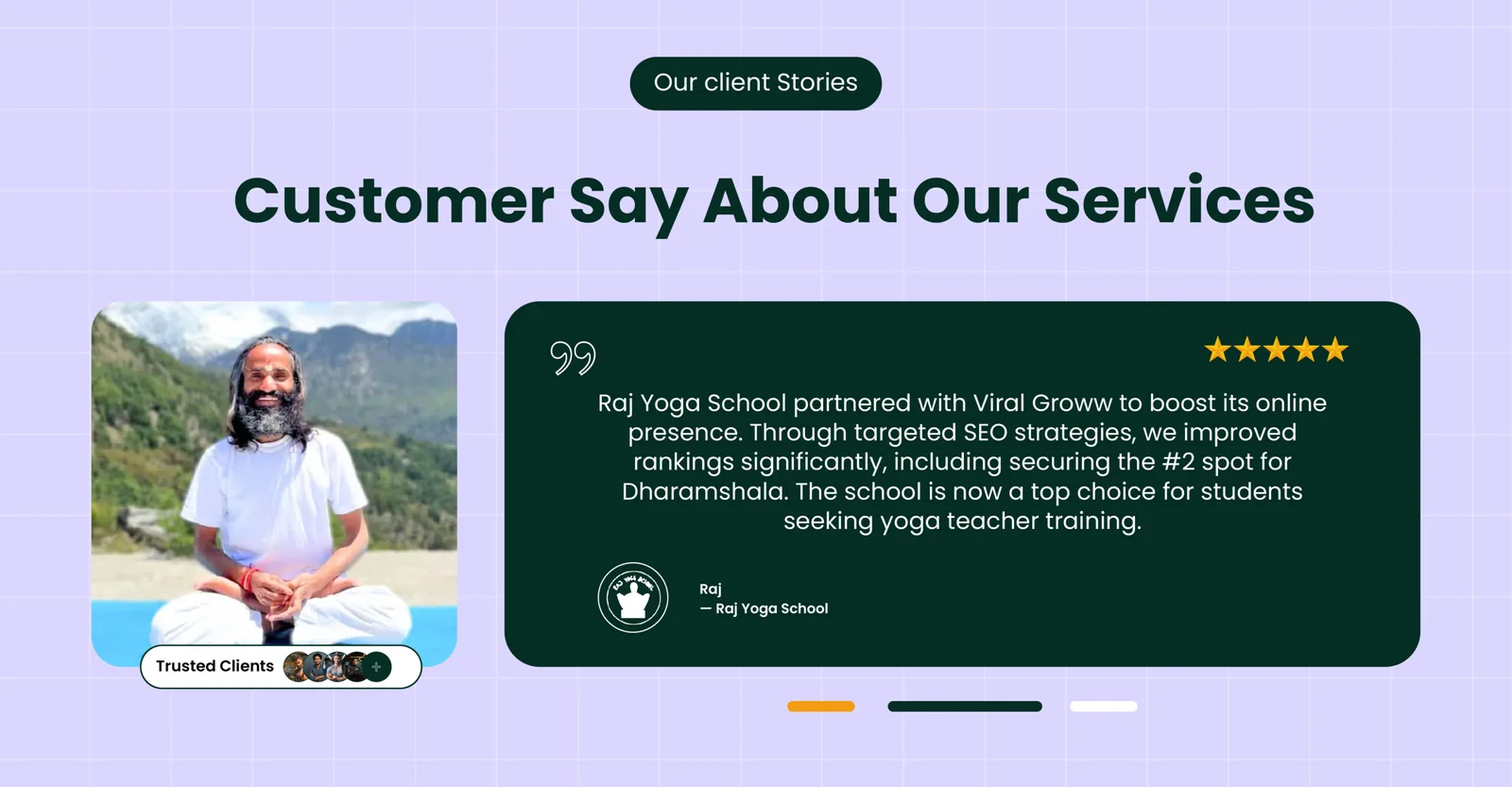
Raj Yoga School’s Journey to the Top of Search Rankings
Nestled between the tranquil peaks of the Himalayas and the sun-kissed beaches of Goa, Raj Yoga School has been a sanctuary for aspiring yoga teachers in India.
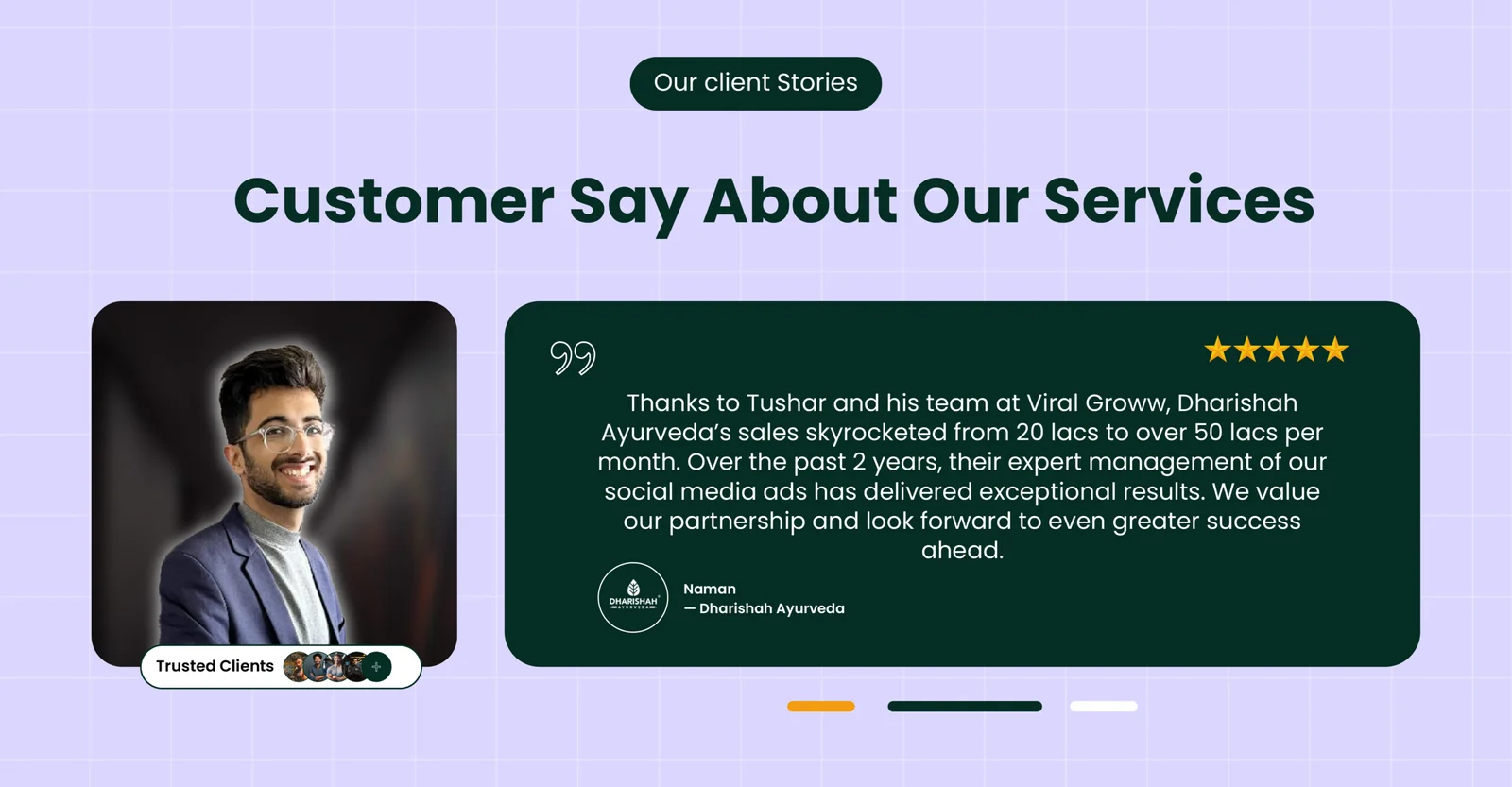
Scaling Dharishah Ayurveda from ₹20 Lakhs to ₹50 Lakhs in Monthly Sales
Dharishah Ayurveda, a promising Ayurvedic brand, had already seen growth through performance marketing, scaling from ₹2 lakhs to ₹20 lakhs in monthly sales (covered in a previous case study).

Building Trust and Revenue for Dharishah Ayurveda with Scalable Facebook Ads
Dharishah Ayurveda, led by CEO Naman Dhamija, is a premium Ayurvedic brand dedicated to promoting natural wellness.
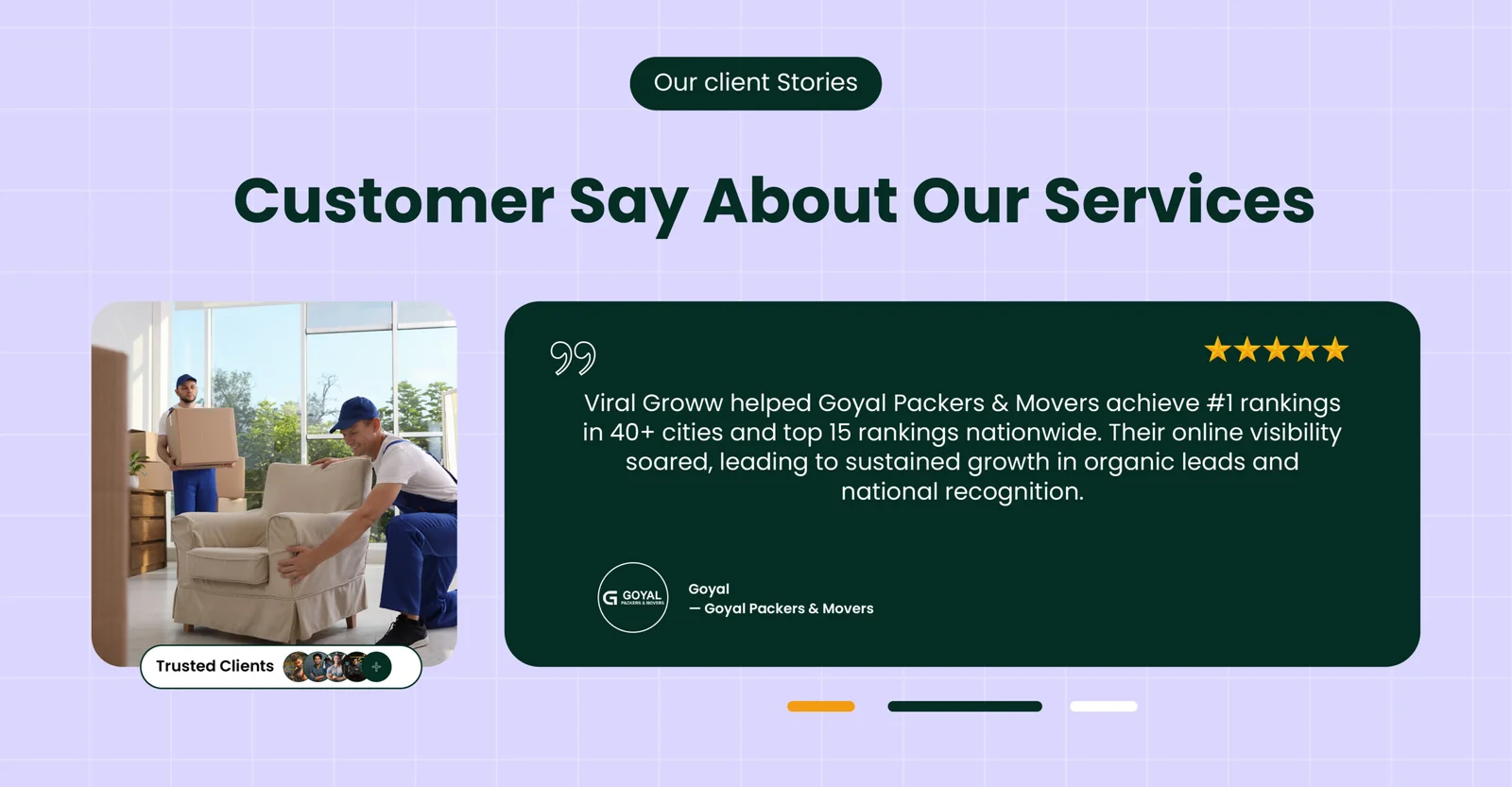
How Goyal Packers & Movers Skyrocketed to #1 in 40+ Cities with White Hat SEO
Goyal Packers and Movers India, owned by Mr. Sampat Singh, is one of the most preferred packers and movers across Northern India, offering exceptional shifting services.





